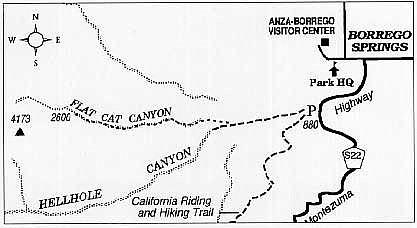 Facebook
Facebook
 X
X
 Instagram
Instagram
 TikTok
TikTok
 Youtube
Youtube
Flat Cat Canyon is the curious name given to a rugged gorge southwest of the Anza-Borrego Desert State Park visitors' center and not far outside the town of Borrego Springs. Park rangers once found a dead bobcat (presumably very dead) in this canyon and followed the honorable Western tradition of assigning colorful names to colorful places. From below, Flat Cat Canyon appears as a steep, boulder-choked ravine -- seemingly of little interest. But its upper reaches hold a surprise or two.
Should you decide to nose your weary way up this canyon, wear long pants and sturdy shoes to help protect you from the needling of cactus spines and the invasive thrusts of catclaw and desert apricot thorns. Serious bushwhacking and rock-scrambling challenges await you, so forget it if you're not ready for a sweaty affair that may involve some frustration with the sometimes-glacial rate of progress.
Begin at the large trailhead parking area near the foot of the Montezuma Grade. This is on the west side of Montezuma Highway, 0.7 mile south of Palm Canyon Drive in Borrego Springs. You'll need an Anza-Borrego parking permit, which costs $5 daily or $50 annually (for information, call the park at 760-767-4205 or 760-767-5311).
Follow the trail leading west, straight toward the wide mouth of Hellhole Canyon, but leave this trail and bend right toward Flat Cat Canyon (which is the narrower and steeper canyon to the north of Hellhole Canyon) after about a mile. Once you get into Flat Cat Canyon, your first mile of travel, partly on a sandy wash and partly over the rocks of the canyon walls, nets you about 1000 feet of elevation. Note the contrast between the dark, desert-varnished rock high on the canyonsides and the whitish, flood-scoured boulders on the lower slopes.
If your stamina and patience allow, continue scrambling uphill, past scattered native palms and perhaps trickles of water (recent rainfall allowing), to a place where the canyon evenly divides at 2600 feet elevation. That's where the canyon's largest grove of about two dozen palms resides. At that point you've come 2.5 miles in all, with an elevation gain of 1800 feet. Return the same way you came. Enjoy the wide view of the desert floor, framed by the canyon's V-shaped profile, on the descent.


Flat Cat Canyon is the curious name given to a rugged gorge southwest of the Anza-Borrego Desert State Park visitors' center and not far outside the town of Borrego Springs. Park rangers once found a dead bobcat (presumably very dead) in this canyon and followed the honorable Western tradition of assigning colorful names to colorful places. From below, Flat Cat Canyon appears as a steep, boulder-choked ravine -- seemingly of little interest. But its upper reaches hold a surprise or two.
Should you decide to nose your weary way up this canyon, wear long pants and sturdy shoes to help protect you from the needling of cactus spines and the invasive thrusts of catclaw and desert apricot thorns. Serious bushwhacking and rock-scrambling challenges await you, so forget it if you're not ready for a sweaty affair that may involve some frustration with the sometimes-glacial rate of progress.
Begin at the large trailhead parking area near the foot of the Montezuma Grade. This is on the west side of Montezuma Highway, 0.7 mile south of Palm Canyon Drive in Borrego Springs. You'll need an Anza-Borrego parking permit, which costs $5 daily or $50 annually (for information, call the park at 760-767-4205 or 760-767-5311).
Follow the trail leading west, straight toward the wide mouth of Hellhole Canyon, but leave this trail and bend right toward Flat Cat Canyon (which is the narrower and steeper canyon to the north of Hellhole Canyon) after about a mile. Once you get into Flat Cat Canyon, your first mile of travel, partly on a sandy wash and partly over the rocks of the canyon walls, nets you about 1000 feet of elevation. Note the contrast between the dark, desert-varnished rock high on the canyonsides and the whitish, flood-scoured boulders on the lower slopes.
If your stamina and patience allow, continue scrambling uphill, past scattered native palms and perhaps trickles of water (recent rainfall allowing), to a place where the canyon evenly divides at 2600 feet elevation. That's where the canyon's largest grove of about two dozen palms resides. At that point you've come 2.5 miles in all, with an elevation gain of 1800 feet. Return the same way you came. Enjoy the wide view of the desert floor, framed by the canyon's V-shaped profile, on the descent.
